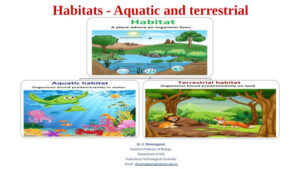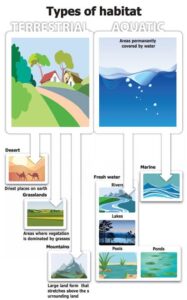Back to: ZOOLOGY 100 Level
I am so happy to see you again, ready to learn something new! Today, we are going to talk about aquatic and terrestrial habitats. This is a very exciting topic because it shows us the different “homes” where animals and plants live. You’ll soon see how these habitats are just like different neighbourhoods in a big Nigerian city!
Aquatic and terrestrial habitats
What is a Habitat?
A habitat is simply the natural home or environment where a plant, animal, or any living thing lives and grows. Just like people live in different types of houses — bungalows, flats, or huts — animals and plants also live in different types of habitats suited for them.

Types of Habitats
- Aquatic Habitats
Aquatic habitats are habitats found in water. These could be freshwater like rivers and lakes or saltwater like oceans and seas.
- Freshwater habitats: These include rivers, lakes, streams, and ponds.
- Examples of animals: Tilapia fish, frogs, crocodiles, and water snails.
- Marine (saltwater) habitats: These are oceans and seas.
- Examples of animals: Whales, sharks, starfish, and crabs.
- Important Facts:
- Animals living in aquatic habitats often have features that help them swim, float, or breathe underwater.
- For example, fishes have gills to breathe underwater, and many aquatic animals have fins to help them move.
- Terrestrial Habitats
Terrestrial habitats are habitats found on land. They include deserts, forests, mountains, grasslands, and even your backyard!
- Deserts: Hot, dry places with very little water.
- Examples: Camels, scorpions, and desert snakes.
- Camels have humps that store fat to survive without food and water for long periods.
- Forests: Areas with many trees and lots of rainfall.
- Examples: Monkeys, eagles, and antelopes.
- Mountains: High, rocky areas with colder temperatures.
- Examples: Mountain goats and snow leopards (found in other parts of the world).
- Grasslands: Wide open spaces with grasses and few trees.
- Examples: Zebras, lions, and gazelles.
- Important Facts:
- Terrestrial animals have adaptations like strong legs for running, thick fur for cold weather, or sharp claws for climbing.

Simple Nigerian Examples
- In Nigeria, the River Niger provides an aquatic habitat for fishes and hippos.
- The Sambisa forest in the North is a terrestrial habitat for many wild animals.
- The Sokoto desert area is a desert habitat where animals must survive with very little water.

Summary
- A habitat is the natural home of a living thing.
- Aquatic habitats are water-based (like rivers and oceans).
- Terrestrial habitats are land-based (like forests and deserts).
- Animals and plants have special features to survive in their specific habitats.
Evaluation
- What is a habitat?
- Mention two examples of aquatic animals.
- Name two types of terrestrial habitats.
- Why do camels survive well in deserts?
- Give one Nigerian example each of aquatic and terrestrial habitats.
Your brain is growing stronger every day, and I am very proud of you! Keep believing in yourself. With Afrilearn by your side, nothing can stop you from reaching your dreams. Let’s keep learning together!
